Wideband Dual-Polarized Filtering Antennas Using Short-Circuited Coupling Structure for 4G/5G Multi-Input-Multi-Output (MIMO) Antenna Decoupling Design
Abstract
1. Introduction
2. Antenna Design Process and Analysis
2.1. The 4G Antenna Design
2.2. The 5G Antenna Design
2.3. Mutual Decoupling of 4G/5G Array with Two Elements
2.4. Mutual Decoupling of 4G/5G Array with Five Elements
3. Conclusions
Author Contributions
Funding
Institutional Review Board Statement
Informed Consent Statement
Data Availability Statement
Conflicts of Interest
References
- Mao, C.-X.; Gao, S.; Wang, Y.; Wang, Z.; Qin, F.; Sanz-Izquierdo, B.; Chu, Q.-X. An Integrated Filtering Antenna Array with High Selectivity and Harmonics Suppression. IEEE Trans. Microw. Theory Tech. 2016, 64, 1798–1805. [Google Scholar] [CrossRef]
- Mao, C.X.; Gao, S.; Wang, Y.; Sanz-Izquierdo, B.; Wang, Z.; Qin, F.; Chu, Q.X.; Li, J.; Wei, G.; Xu, J. Dual-Band Patch Antenna with Filtering Performance and Harmonic Suppression. IEEE Trans. Antennas Propag. 2016, 64, 4074–4077. [Google Scholar] [CrossRef]
- Chen, F.-C.; Hu, H.-T.; Li, R.-S.; Chu, Q.-X. Design of Filtering Microstrip Antenna Array with Reduced Sidelobe Level. IEEE Trans. Antennas Propag. 2017, 65, 903–908. [Google Scholar] [CrossRef]
- Chen, J.-X.; Zhang, Y.-J.; Cai, J.; Li, Y.-L.; Yang, Y.-J. Overall Study of Frequency-Agile Mechanism of Varactor-Loaded λ/4 Resonator for Designing Tunable Filter with Stable Wide Stopband. IEEE Trans. Ind. Electron. 2019, 66, 6302–6310. [Google Scholar] [CrossRef]
- Yang, W.J.; Pan, Y.M.; Hu, P.F. Circularly Polarized Filtering Dielectric Resonator Antenna. In Proceedings of the 2022 IEEE Conference on Antenna Measurements and Applications (CAMA), Guangzhou, China, 14–17 December 2022; pp. 1–3. [Google Scholar]
- Tang, H.; Tong, C.; Chen, J. Differential Dual-Polarized Filtering Dielectric Resonator Antenna. IEEE Trans. Antennas Propag. 2018, 66, 4298–4302. [Google Scholar] [CrossRef]
- Yan, N.; Song, D.; Luo, Y.; Ma, K. A Low-Cost Miniaturized Filtering Dielectric Resonator Antenna Based on SISL for 5G Applications. IEEE Trans. Antennas Propag. 2022, 70, 11344–11352. [Google Scholar] [CrossRef]
- Zhang, Y.; Zhang, Y.; Huang, K.; Liu, S.-J.; Zhang, X.Y.; Liu, Q.H. A Reconfigurable Patch Antenna with Linear and Circular Polarizations Based on Double-Ring-Slot Feeding Structure. IEEE Trans. Antennas Propag. 2022, 70, 11389–11400. [Google Scholar] [CrossRef]
- Li, Y.; Zhao, Z.; Tang, Z.; Yin, Y.; Fed, D. Dual-Band Dual-Polarized Filtering Antenna with High Selectivity for 5G Sub-6 GHz Base Station Applications. IEEE Trans. Antennas Propag. 2020, 68, 3231–3236. [Google Scholar] [CrossRef]
- Zhang, Y.; Zhang, X.-Y.; Liu, Q.-H. Dual-Polarized Filtering Magnetoelectric Dipole Antenna Utilizing Intrinsic Highpass Filter Network and Integrated Lowpass Filter Network. IEEE Trans. Antennas Propag. 2021, 69, 8090–8099. [Google Scholar] [CrossRef]
- Luo, Y.; Zhao, S.; Yan, N.; An, W.; Ma, K.; Meng, F. A Multicompressed-High-Order Modes Dipole Antenna with Wide-Beam and High-Gain Radiations in Two Different Bands. IEEE Antennas Wirel. Propag. Lett. 2023, 22, 1231–1235. [Google Scholar] [CrossRef]
- Wen, L.; Gao, S.; Yang, Q.; Luo, Q.; Yin, Y.; Ren, X. A Compact Monopole Antenna with Filtering Response for WLAN Applications. In Proceedings of the 2019 International Symposium on Antennas and Propagation (ISAP), Xi’an, China, 27–30 October 2019; pp. 1–3. [Google Scholar]
- Chen, C. A Compact Wideband Filtering Omnidirectional Dipole Antenna Without Extra Circuits. IEEE Trans. Antennas Propag. 2022, 70, 1729–1739. [Google Scholar] [CrossRef]
- Liu, N.-W.; Liang, Y.-D.; Zhu, L.; Liu, Z.-X.; Fu, G. A Low-Profile, Wideband, Filtering-Response, Omnidirectional Dielectric Resonator Antenna Without Enlarged Size and Extra Feeding Circuit. IEEE Antennas Wirel. Propag. Lett. 2021, 20, 1120–1124. [Google Scholar] [CrossRef]
- Liu, J.A.; Cao, Y.F.; Zhang, X.Y. A Pattern-Reconfigurable Filtering Patch Antenna Using Embedded Resonators and Switchable Elements. IEEE Trans. Antennas Propag. 2022, 70, 3828–3833. [Google Scholar] [CrossRef]
- Yang, S.J.; Duan, W.; Liu, Y.Y.; Ye, H.; Yang, H.; Zhang, X.Y. Compact Dual-Band Base-Station Antenna Using Filtering Elements. IEEE Trans. Antennas Propag. 2022, 70, 7106–7111. [Google Scholar] [CrossRef]
- Liu, X.; Gao, S.; Hu, W.; Wen, L.; Luo, Q.; Sanz-Izquierdo, B.; Chen, X.; Qian, L.; Sumantyo, J.T.S.; Yang, X.-X. A Compact Dual-Polarized Filtering Antenna with Steep Cut-Off for Base-Station Applications. IEEE Trans. Antennas Propag. 2022, 70, 5941–5946. [Google Scholar] [CrossRef]
- Da Liu, Q.; Dong, Q.; Wen, J.X.; Ye, L.H.; Wu, D.-L.; Zhang, X.Y. Compact Wideband Patch Filtenna with Enhanced Out-of-Band Suppression. IEEE Antennas Wirel. Propag. Lett. 2023, 22, 2310–2314. [Google Scholar] [CrossRef]
- Liu, T.; Jiang, J.; Zhao, L.; Zhao, G.; Zhai, H.; Cai, Y.-M.; Chen, T.; Xu, W. Compact U6G Massive MIMO Antenna Arrays with Double-Layer Partial Reflective Decoupling Layers for Mutual Coupling Suppression. IEEE Open J. Antennas Propag. 2023, 4, 764–778. [Google Scholar] [CrossRef]
- Zhao, G.; Liu, T.; Jiang, J.; Zhao, L.; Huang, G.-L.; Lin, W. Polarization Selective Partial Reflective Decoupling Layers for Mutual Coupling Reduction of Two Closely Spaced Dual-Polarized Antennas. IEEE Trans. Antennas Propag. 2022, 70, 11205–11210. [Google Scholar] [CrossRef]
- He, D.; Yu, Q.; Chen, Y.; Yang, S. Dual-Band Shared-Aperture Base Station Antenna Array with Electromagnetic Transparent Antenna Elements. IEEE Trans. Antennas Propag. 2021, 69, 5596–5606. [Google Scholar] [CrossRef]
- Chang, Y.; Chu, Q.-X. Broadband Dual-Polarized Electromagnetic Transparent Antenna for Cross-Band Scattering Suppression. IEEE Antennas Wirel. Propag. Lett. 2022, 21, 1452–1456. [Google Scholar] [CrossRef]
- Sun, H.-H.; Zhu, H.; Ding, C.; Jones, B.; Guo, Y. Scattering Suppression in a 4G and 5G Base Station Antenna Array Using Spiral Chokes. IEEE Antennas Wirel. Propag. Lett. 2020, 19, 1818–1822. [Google Scholar] [CrossRef]
- Li, Y.; Chu, Q.-X. Self-Decoupled Dual-Band Shared-Aperture Base Station Antenna Array. IEEE Trans. Antennas Propag. 2022, 70, 6024–6029. [Google Scholar] [CrossRef]



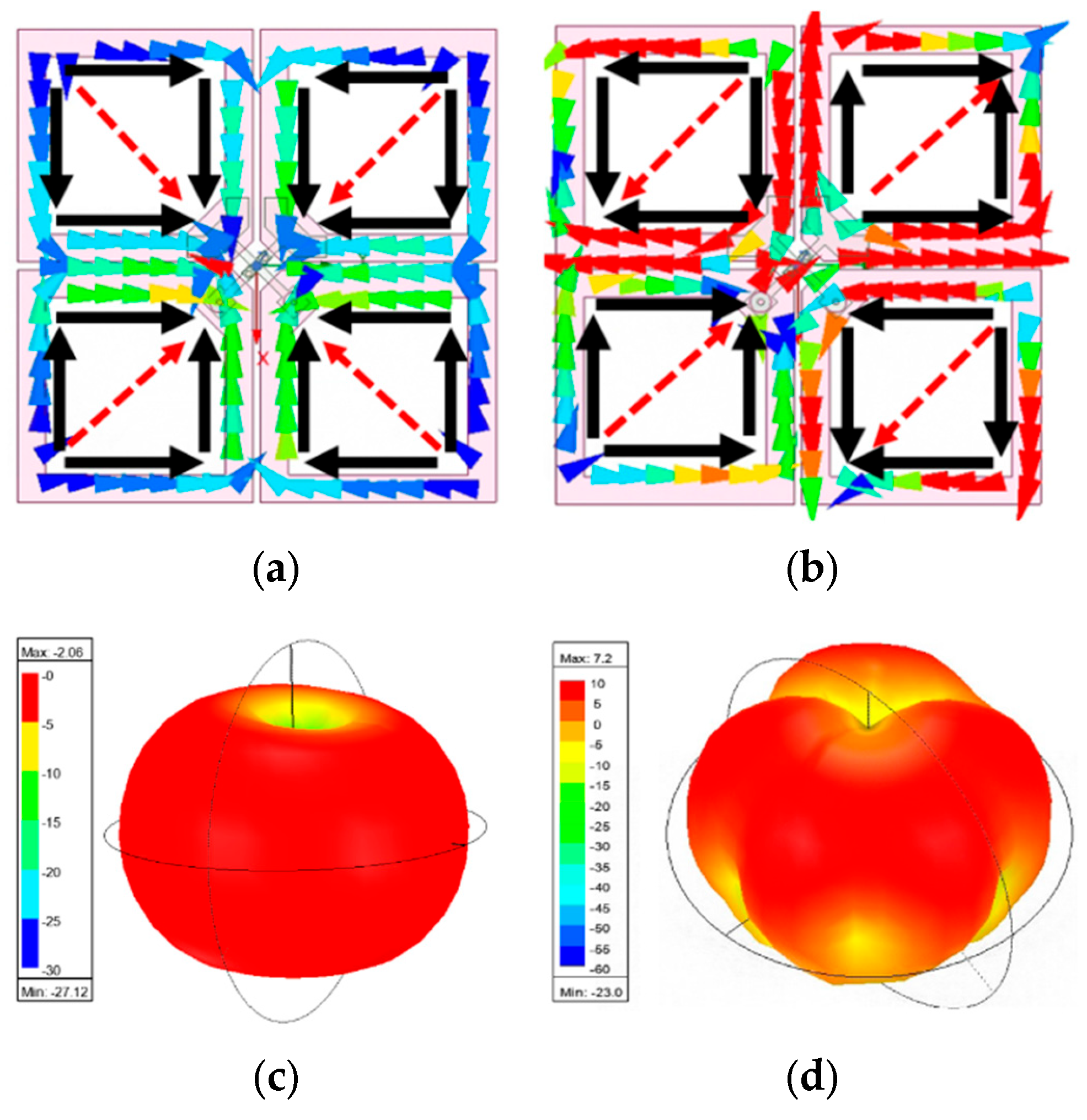


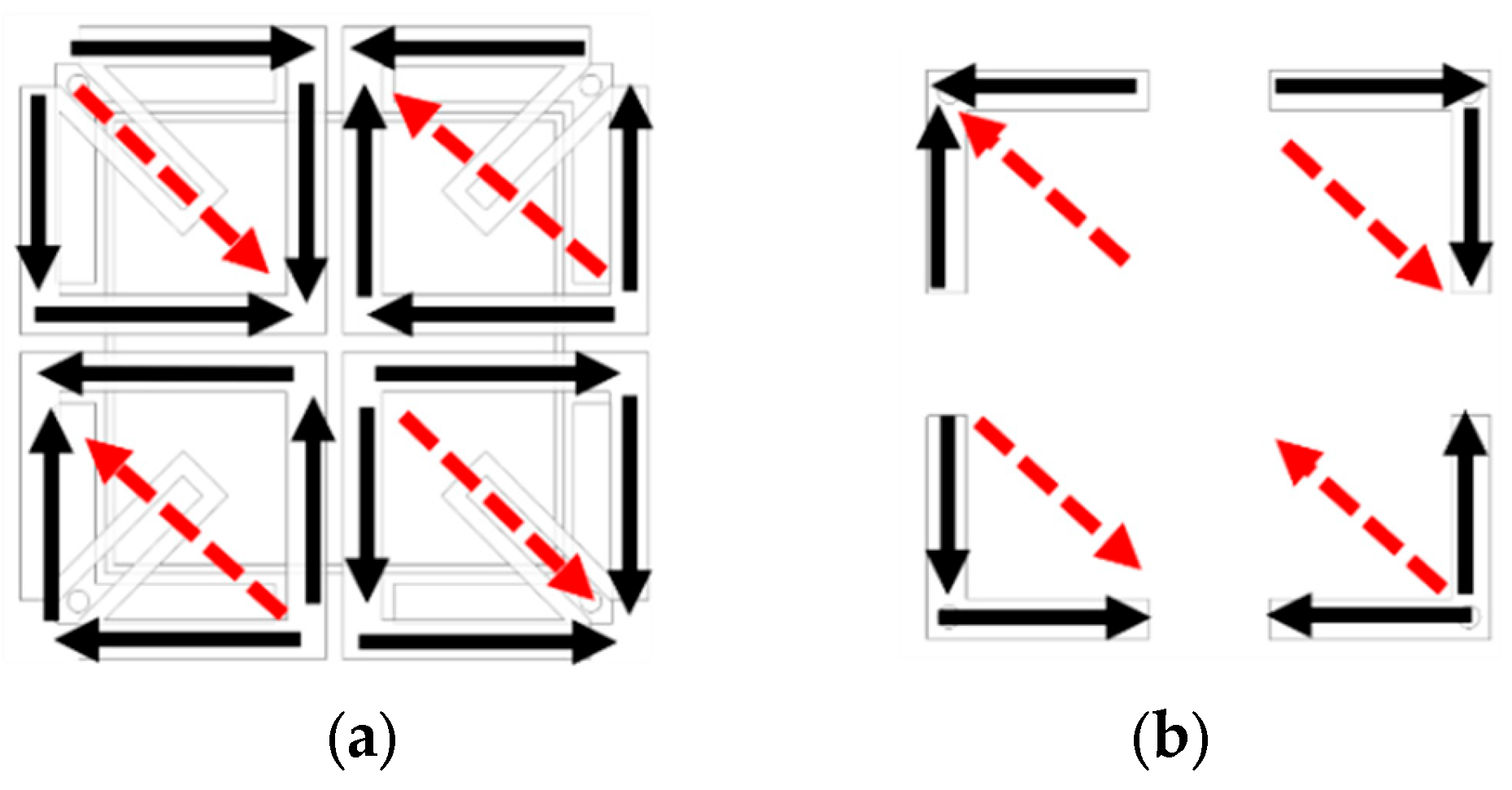





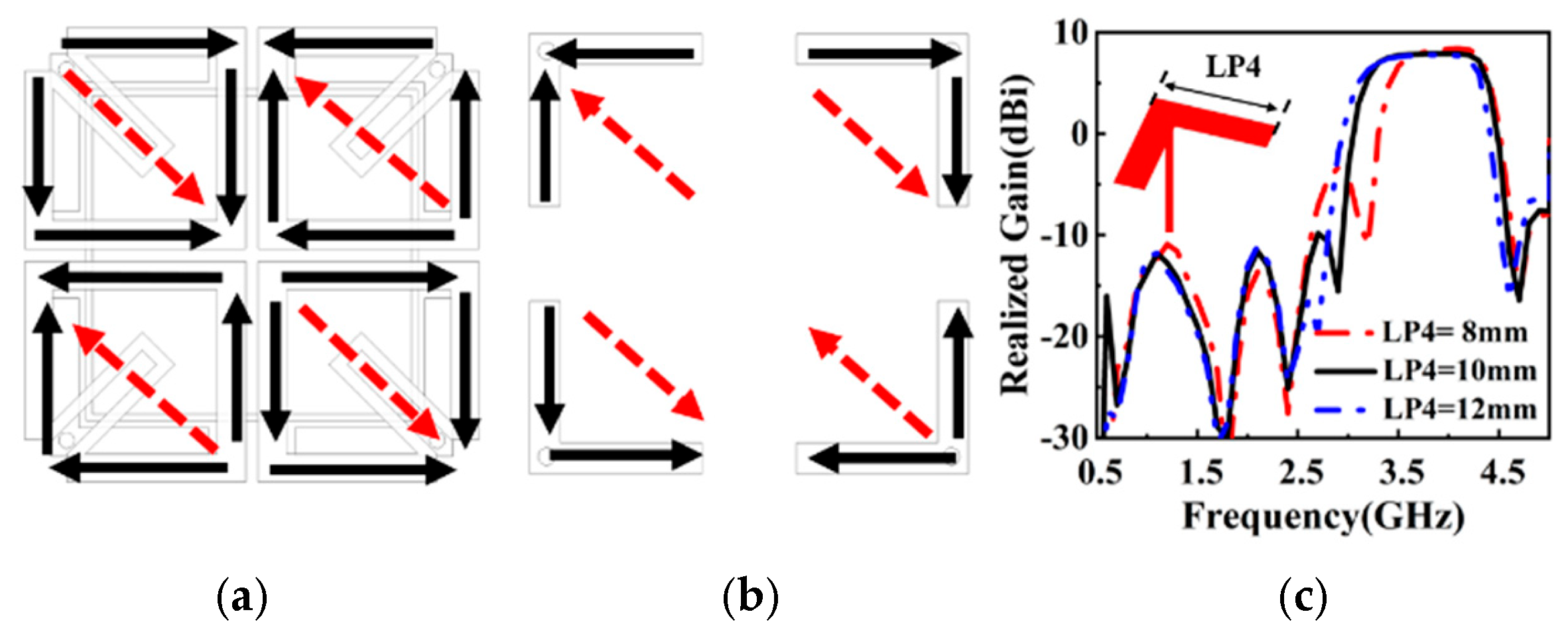
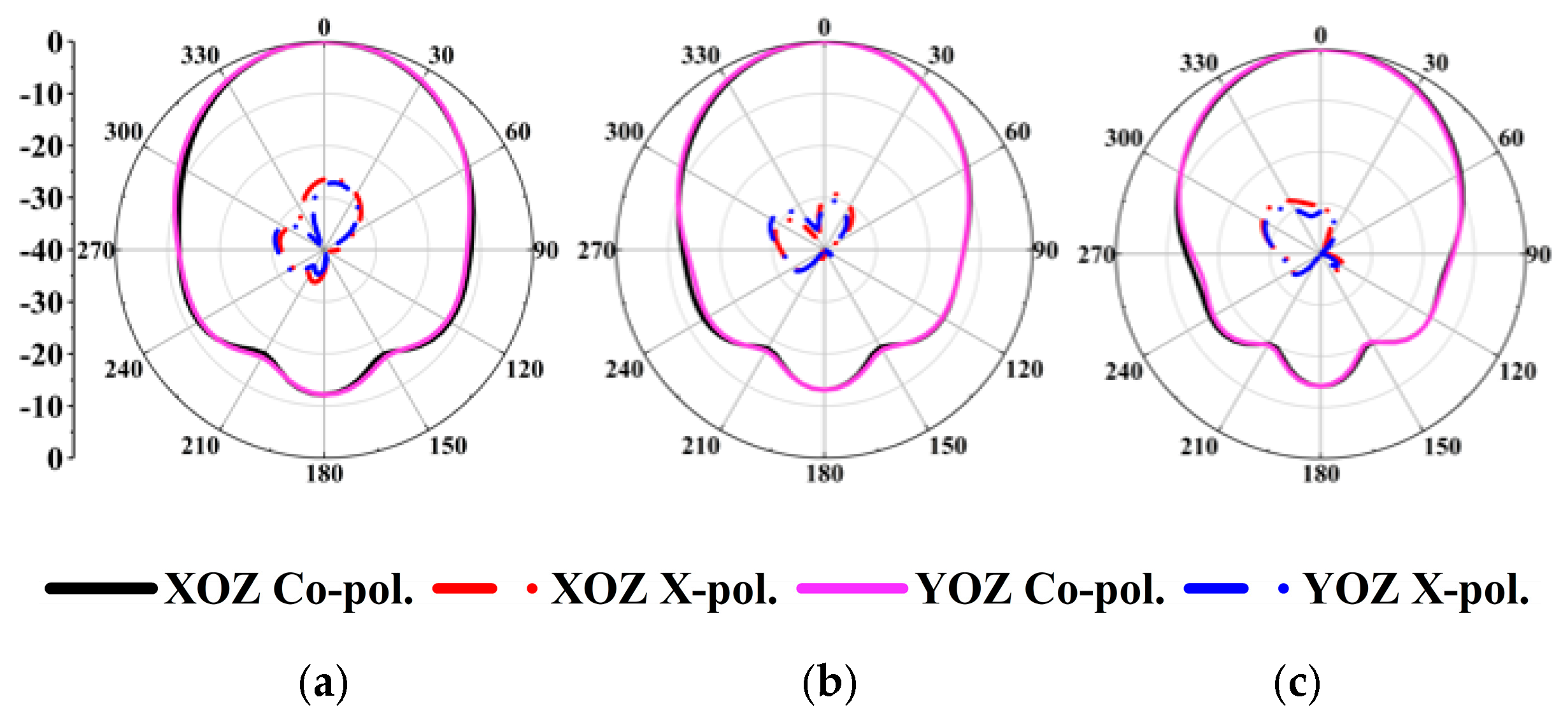



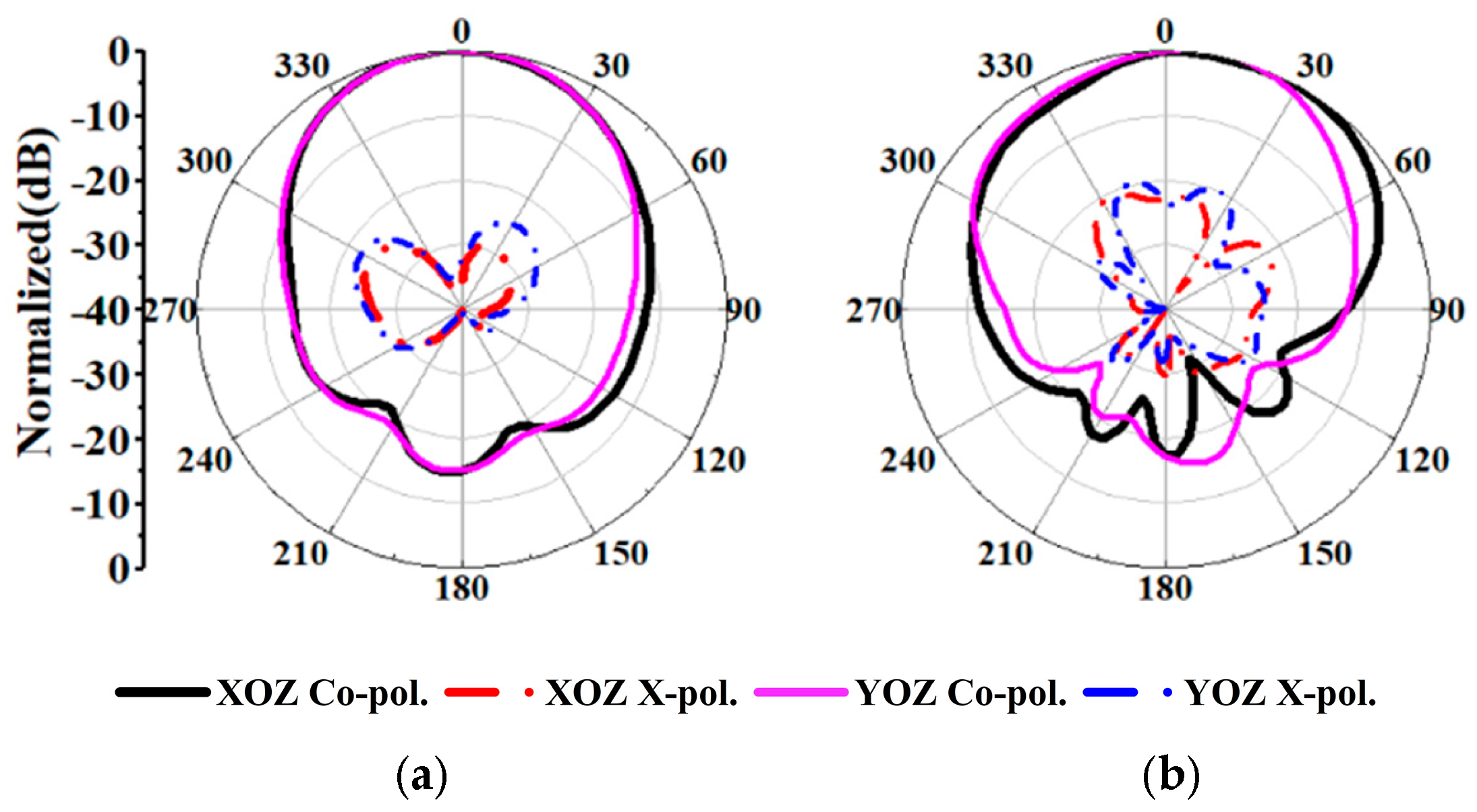
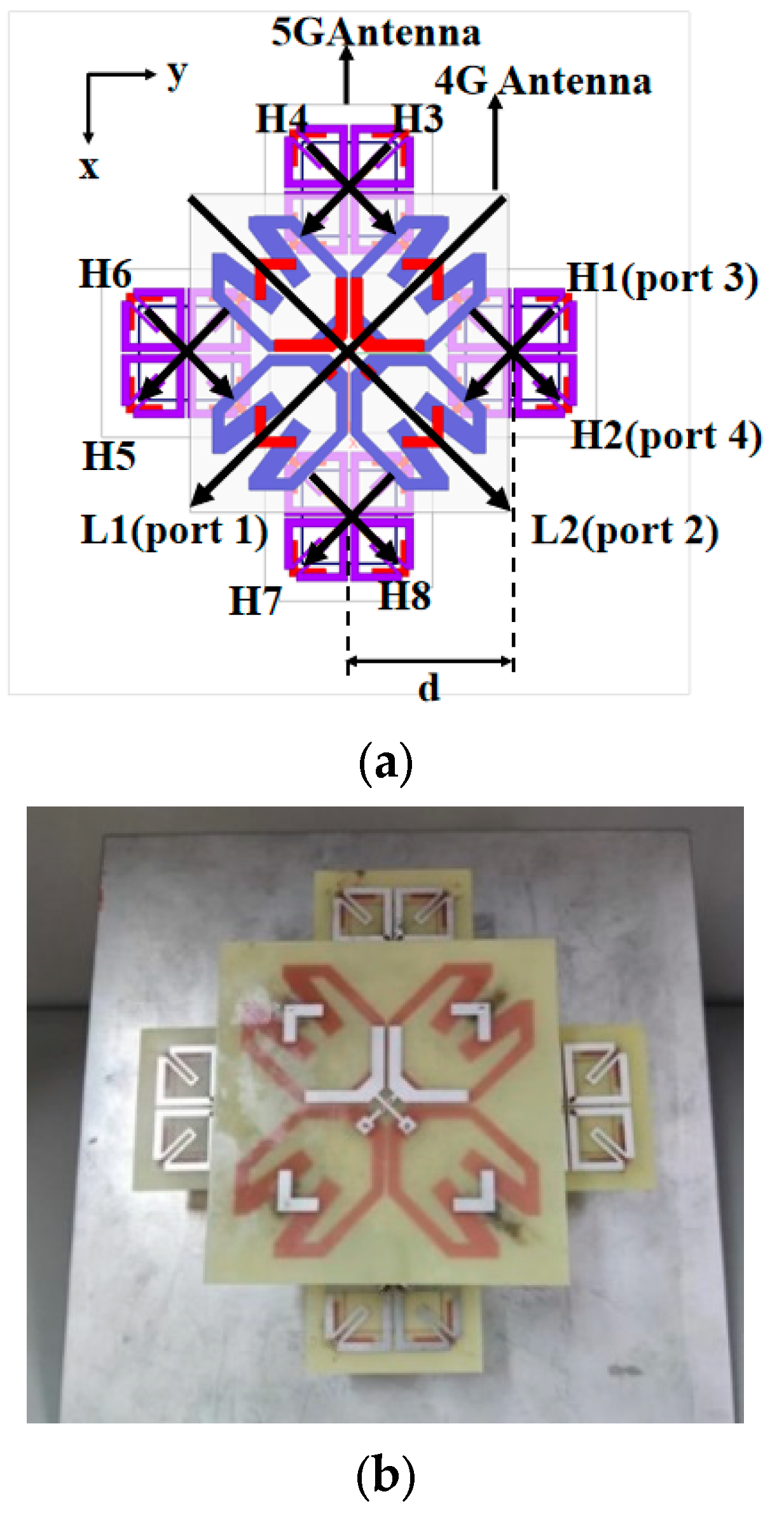
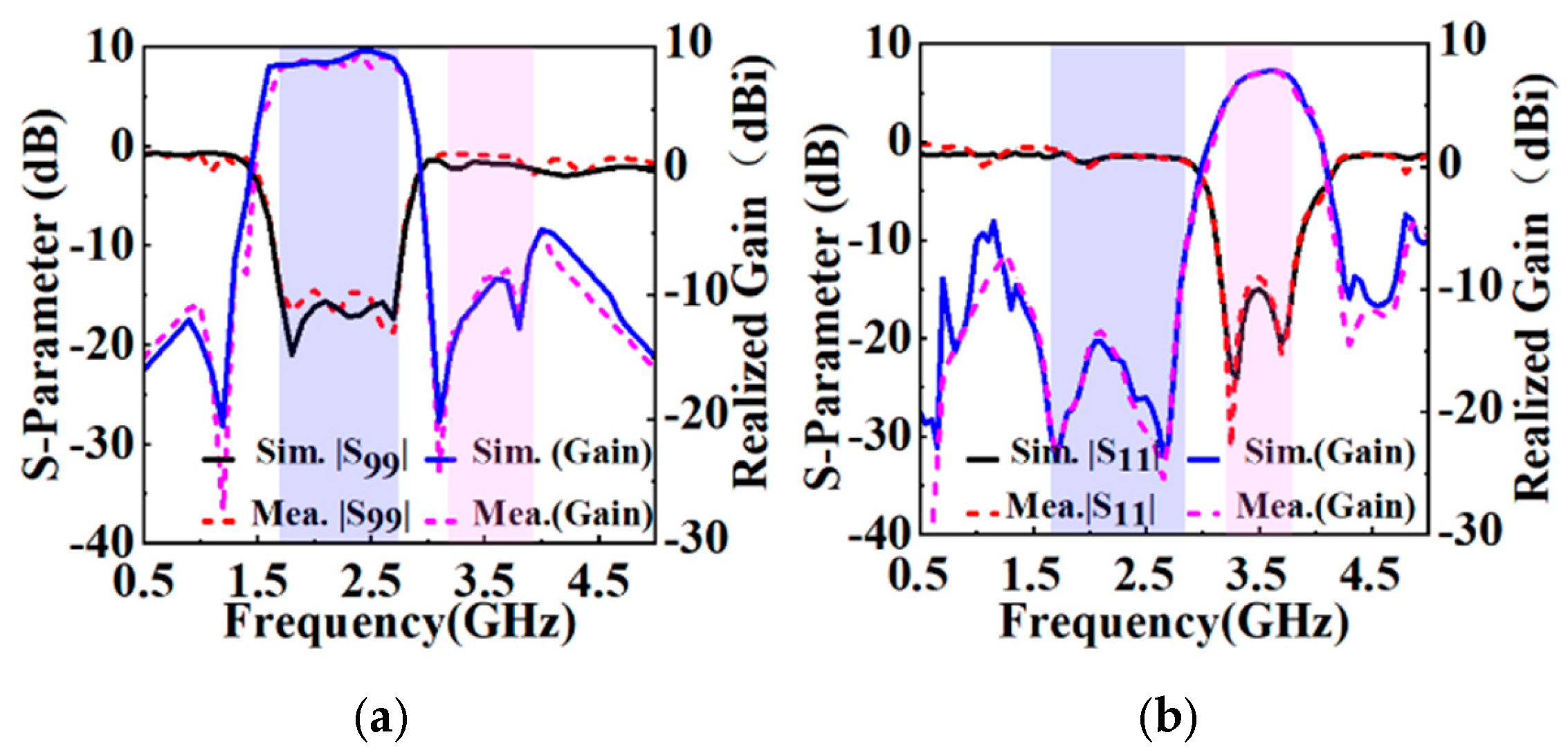

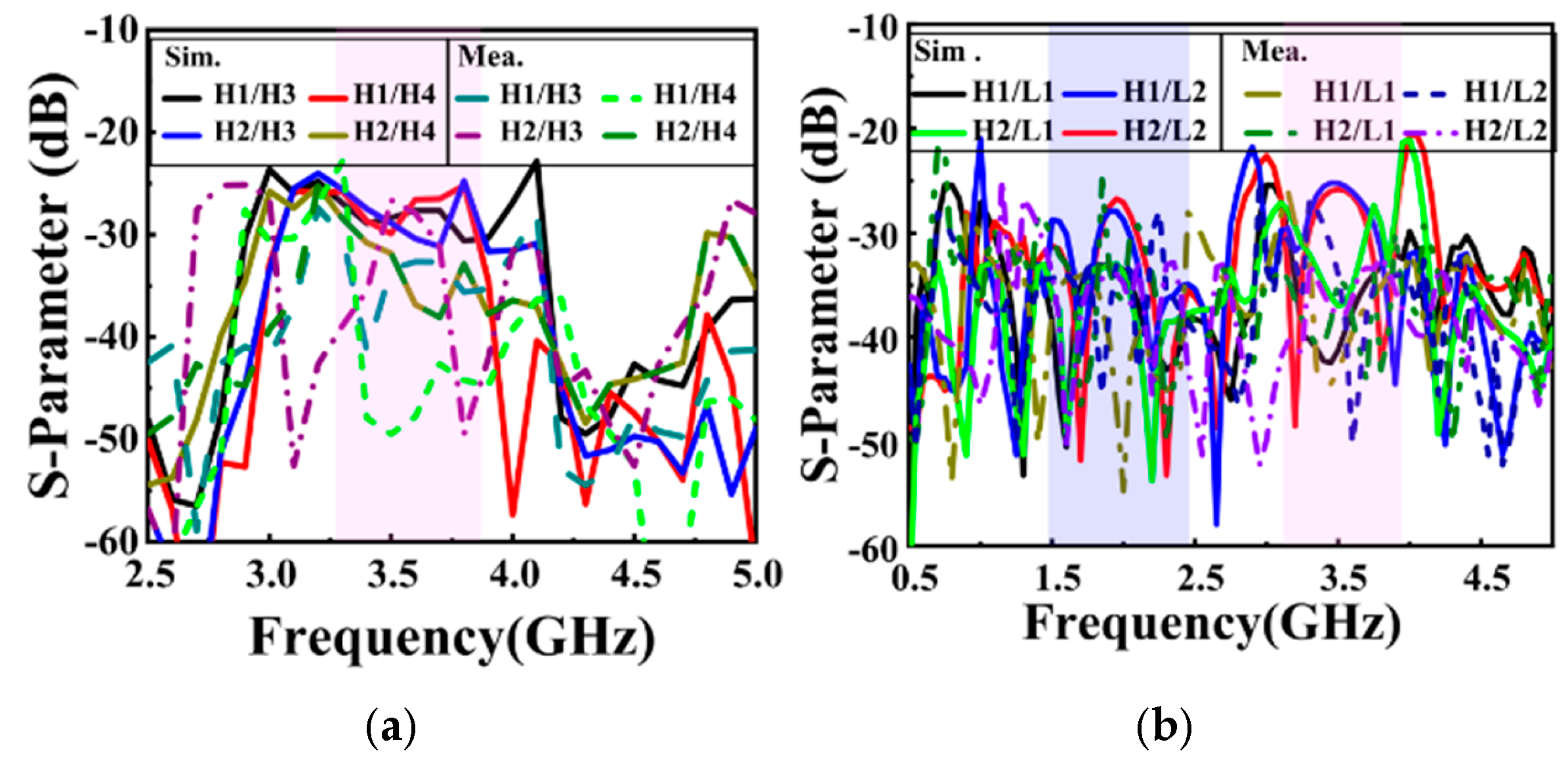
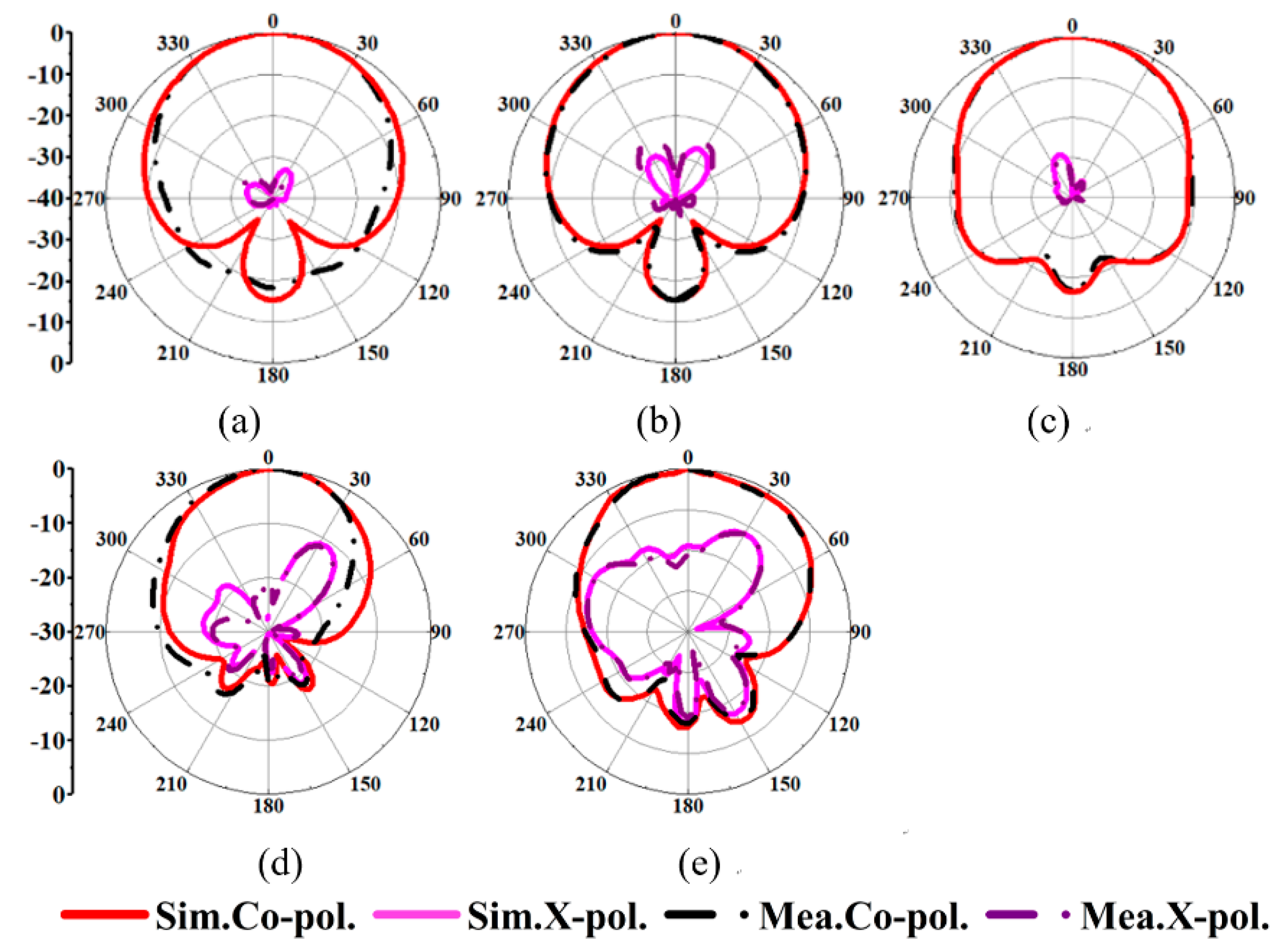
Disclaimer/Publisher’s Note: The statements, opinions and data contained in all publications are solely those of the individual author(s) and contributor(s) and not of MDPI and/or the editor(s). MDPI and/or the editor(s) disclaim responsibility for any injury to people or property resulting from any ideas, methods, instructions or products referred to in the content. |
© 2025 by the authors. Licensee MDPI, Basel, Switzerland. This article is an open access article distributed under the terms and conditions of the Creative Commons Attribution (CC BY) license (https://creativecommons.org/licenses/by/4.0/).
Share and Cite
Song, H.; Zhang, F.; Duan, B. Wideband Dual-Polarized Filtering Antennas Using Short-Circuited Coupling Structure for 4G/5G Multi-Input-Multi-Output (MIMO) Antenna Decoupling Design. Photonics 2025, 12, 259. https://doi.org/10.3390/photonics12030259
Song H, Zhang F, Duan B. Wideband Dual-Polarized Filtering Antennas Using Short-Circuited Coupling Structure for 4G/5G Multi-Input-Multi-Output (MIMO) Antenna Decoupling Design. Photonics. 2025; 12(3):259. https://doi.org/10.3390/photonics12030259
Chicago/Turabian StyleSong, Haitao, Feifei Zhang, and Baoxing Duan. 2025. "Wideband Dual-Polarized Filtering Antennas Using Short-Circuited Coupling Structure for 4G/5G Multi-Input-Multi-Output (MIMO) Antenna Decoupling Design" Photonics 12, no. 3: 259. https://doi.org/10.3390/photonics12030259
APA StyleSong, H., Zhang, F., & Duan, B. (2025). Wideband Dual-Polarized Filtering Antennas Using Short-Circuited Coupling Structure for 4G/5G Multi-Input-Multi-Output (MIMO) Antenna Decoupling Design. Photonics, 12(3), 259. https://doi.org/10.3390/photonics12030259




